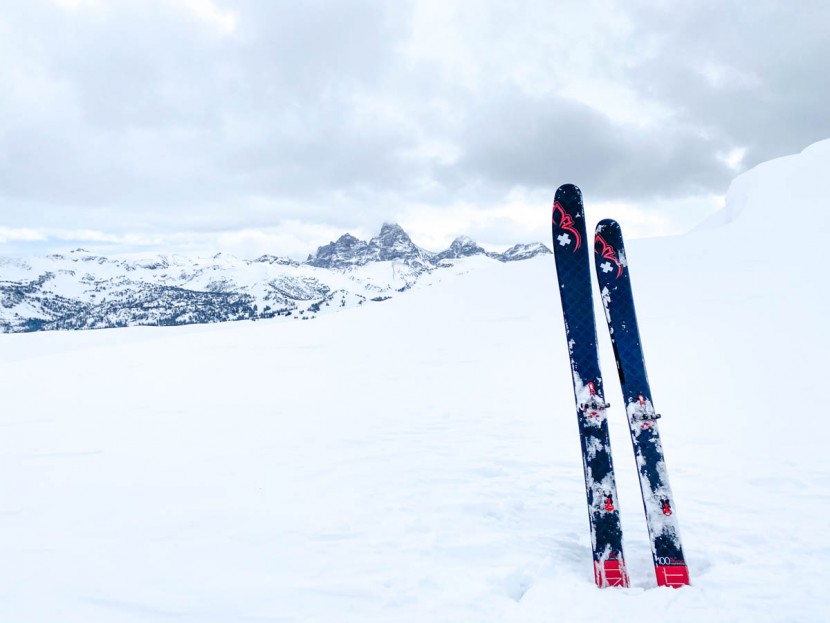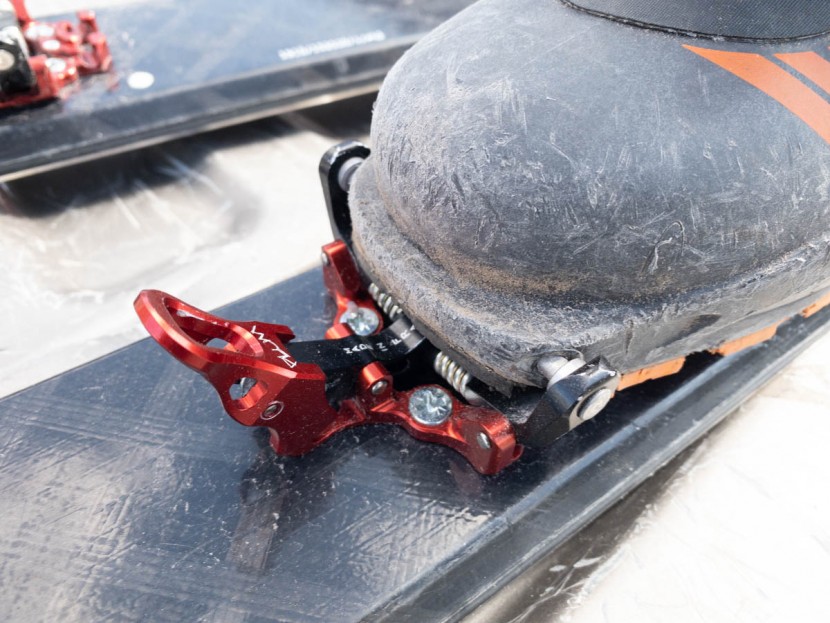Plum R170 Review

Our Verdict
Our Analysis and Test Results
This is a specialized piece of equipment. As such, when compared to more versatile, all-around equipment, its overall score inherently suffers. However, for the right user and usage patterns, this binding could be just right. A “skimo” race style binding that is, ostensibly, manufactured with more durability. The all-metal construction tempts one into using it for “day-to-day” backcountry skiing. We can endorse this sort of use with caveats.
Touring Performance
Paradoxically, the ultralight construction of the Plum R170 somewhat compromises touring performance. Of course, one could consider weight as an attribute of touring performance. However, we choose to separate that into its own scoring metric. When we do that, we look here at only the mechanical touring performance. We consider range of motion and the ergonomic features like heel lifters.
The R170 has an excellent range of motion. What it lacks is a choice of heel lift. You can tour in exactly one moderately lifted position. You cannot easily tour “flat on ski”, nor is there a “stiletto” heel lift mode. For beginning backcountry skiers, these gaps will be sorely noticed. On the flip side, the usage patterns of the world's best ski mountaineers show that one moderate heel lift is all that is needed. Everything that has been skied has been skied on race-style ski gear. The best in the world are doing so on race-style bindings.
Downhill Performance
Just like with touring performance, and even more so, you do not choose this binding for downhill performance. First, and most importantly, release tension is fixed, and directions of release are limited. No third party certifying body has inspected and approved the release function of the Plum R170. If you desire lower release values, you will be locked into the Plum harder than you want. If you desire higher release values, you risk coming out unexpectedly, or you must choose (against manufacturers and OGL recommendations) to lock the toes of the bindings, essentially bolted to your skis.
In terms of downhill performance, we also consider stack height and binding delta. Stack height is the distance of your boot sole from the ski top sheet, and binding delta is the difference in height between toe and heel. We carefully measured these things and found the Plum R170 to have very low values of both. The performance impact of both are debatable. Most agree that, with backcountry skis, boots, and usage patterns, stack height doesn't matter too much and that binding delta has a sweet spot that is considerably more than what the Plum Race provides.
The most potential dramatic issue with stack height comes when the user has wide boots, narrow skis, and steep, firm terrain. In these specific conditions, lower stack height makes it more likely that you will “boot out”, or bump your boot into the snow surface, dislodging edge grip. Binding delta (heel higher than toe) helps some skiers adjust their stance in otherwise soft and upright lightweight touring boots. The fact is, our test team is made up mainly of skiers with good, adaptable technique could hardly notice the differences in stack height and binding delta. Nonetheless, some will really notice this and need to consider it in their binding choices.
The Plum R170 has, objectively, poor downhill ski performance. However, we'd argue that something like 90% of a touring binding's downhill job is to simply hold your heel and toe in place while you wiggle your butt. This Plum does this just fine. For emergencies and really serious skiing, we further distinguish bindings by examining the remaining 10%. In some ways, we ("we" being the entire ski equipment community) exaggerate the importance and impact of things like release value, binding geometry, and elasticity. When we examine carefully and academically, it is clear that something with certified release and sophisticated boot retention has much better downhill performance than the minimalist Plum. However, when you look at the gnarliest of backcountry skiing, you see a remarkable amount of this race-style equipment. In application, these Plum bindings do all that most need them to do, and they do it well.
Ease of Use
Simplicity makes for easy use. Step in, lock the toes, skin away. Switching to ski mode requires a manual (like, with your actual “manus” -Latin for hand), reach and flip. Hip-mobility-challenged skiers will be a little bummed out by this; some bindings you can flip to ski mode with a pole. Switching to uphill mode from ski mode requires exiting the binding and stepping back in. This is typical of most tech-style ski bindings.
These bindings are basically what the fastest backcountry skiers in the world use to win races. In those races, the keys are giant legs, voluminous lungs, light gear, and lightning-fast transitions. Well practiced, the R170 enables the fastest possible transitions.
Weight
Weight is king for human-powered endeavors. For backcountry skiing, the main reason you would choose the R170 is weight; it is for weight savings that we chose it. They weigh 170g (confirmed on our scale. 199g with screws). That's where they get their name. The Plum R150 drops weight by omitting the heel adjustment plate; otherwise, these two are the same as one another.
Durability
The all-metal construction of the superlight Race inspires confidence, especially for such miniaturized equipment. With an earlier tested version of this binding, we did have a failure of the binding function. It seems odd to call this a durability issue, as the issue was that it held on too tightly as if it were too durable. Nonetheless, it was a legitimate failure of the function. As such, it needs to be reflected in our review. We have not had any such failure in subsequent iterations of this and other Plum bindings.
Aside from the one functional issue, we have found the R170 to be reliable and predictable for miles and miles and hundreds of thousands of vertical feet.
Value
In a grams per dollar calculation, the R170 is ridiculously expensive. We're talking near bicycle-dork levels of expense to save these grams. Nonetheless, the weight savings are real; they're on the end of your legs (therefore exaggerating the weight differences), and the performance is “good enough”. If they're for you, the R170 bindings are worth the price.
Conclusion
Using “race style” backcountry gear for day-to-day use is aggressive. However, many do it with great success, including our lead test editor. Given the prodigious weight savings, the compromises in performance for the Plum R170 are worth it.
| Awards | |
|---|---|
| Price | $445 List |
Overall Score  |
|
| Star Rating | |
| Bottom Line | Superlight bindings for light to medium duty backcountry skiing; choose these for simplicity and their all-metal construction |
| Pros | Light, simple |
| Cons | Limited release functionality, no brakes, only one heel elevation |
| Rating Categories | Plum R170 |
| Weight (35%) | |
| Downhill Performance (25%) | |
| Touring Performance (20%) | |
| Ease of Use (15%) | |
| Construction Quality (5%) | |
| Specifications | Plum R170 |
| Weight of 1 binding and screws, lightest possible configuration (in grams) | 199 |
| Release Value Range | 8 Fixed |
| Brakes? | No |
| Brake Width Options | N/A |
| Weight of 2 bindings, common setup (pounds) | 0.88 |
| Weight of 2 bindings (in grams). Multiple options are noted where we have tested multiple options. | 398 |
| Stack height: average of toe and heel pin height (in mm) | 34 |
| Toe/heel delta: difference in height between heel pins and toe pins (in mm) | 4 |
| Meets ISO/DIN Standard? | Yes |
| Ski Crampon compatible? | With aftermarket part. Best with Plum brand. "Standard" Dynafit/B&D style ski crampons can be lightly filed to work. |











